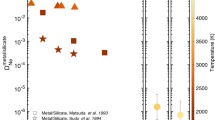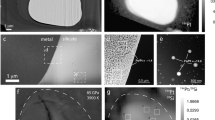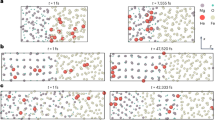Abstract
Core formation on the Earth and Mars involved the physical separation of metal and silicate, most probably in deep magma oceans1,2,3,4. Although core-formation models explain many aspects of mantle geochemistry, they have not accounted for the large differences observed between the compositions of the mantles of the Earth (∼8?wt% FeO) and Mars (∼18?wt% FeO) or the smaller mass fraction of the martian core5,6,7. Here we explain these differences as a consequence of the solubility of oxygen in liquid iron-alloy increasing with increasing temperature. We assume that the Earth and Mars both accreted from oxidized chondritic material. In a terrestrial magma ocean, 1,200–2,000?km deep, high temperatures resulted in the extraction of FeO from the silicate magma ocean owing to high solubility of oxygen in the metal. Lower temperatures of a martian magma ocean resulted in little or no extraction of FeO from the mantle, which thus remains FeO-rich. The FeO extracted from the Earth's magma ocean may have contributed to chemical heterogeneities in the lowermost mantle8, a FeO-rich D″ layer9 and the light element budget of the core10,11.
This is a preview of subscription content, access via your institution
Access options
Subscribe to this journal
Receive 51 print issues and online access
$199.00 per year
only $3.90 per issue
Buy this article
- Purchase on Springer Link
- Instant access to full article PDF
Prices may be subject to local taxes which are calculated during checkout



Similar content being viewed by others
References
Li, J. & Agee, C. B. Geochemistry of mantle–core differentiation at high pressure. Nature 381, 686–689 (1996)
Li, J. & Agee, C. B. The effect of pressure, temperature, oxygen fugacity and composition on partitioning of nickel and cobalt between liquid Fe-Ni-S alloy and liquid silicate: Implications for the Earth's core formation. Geochim. Cosmochim. Acta 65, 1821–1832 (2001)
Righter, K., Drake, M. J. & Yaxley, G. Prediction of siderophile element/silicate partition coefficients to 20?GPa and 2800?°C: the effects of pressure, temperature, oxygen fugacity, and silicate and metallic melt compositions. Phys. Earth Planet. Inter. 100, 115–134 (1997)
Righter, K., Hervig, R. L. & Kring, D. A. Accretion and core formation on Mars: molybdenum contents of melt inclusion glasses in three SNC meteorites. Geochim. Cosmochim. Acta 62, 2167–2177 (1998)
Anderson, D. L. Theory of the Earth (Blackwell, Boston, 1989)
Dreibus, G. & Wanke, H. Mars, a volatile-rich planet. Meteoritics 20, 367–381 (1985)
McSween, H. Y. Jr What we have learnt about Mars from SNC meteorites. Meteoritics 29, 757–779 (1994)
Kellogg, L. H., Hager, B. H. & van der Hilst, R. D. Compositional stratification in the deep mantle. Science 283, 1881–1884 (1999)
Garnero, E. J., Revenaugh, J., Williams, Q., Lay, T. & Kellogg, L. H. in The Core-Mantle Boundary Region (eds Gurnis, M., Wysession, M. E., Knittle, E. & Buffett, B. A.) 319–334 (Geodynamics Series 28, Am. Geophys. Union, Washington, 1998)
Poirier, J.-P. Light elements in the Earth's outer core: A critical review. Phys. Earth Planet. Inter. 85, 319–337 (1994)
Hillgren, V., Gessmann, C. K. & Li, J. in Origin of the Earth and Moon (eds Canup, R. & Righter, K.) 245–263 (Univ. Arizona Press, Tucson, 2000)
Melosh, H. J. in Origin of the Earth (eds Newsom, H. E. & Jones, J. H.) 69–83 (Oxford Univ. Press, Oxford, 1990)
Stevenson, D. J. in Origin of the Earth (eds Newsom, H. E. & Jones, J. H.) 231–249 (Oxford Univ. Press, Oxford, 1990)
Gessmann, C. K. & Rubie, D. C. The effect of temperature on the partitioning of Ni, Co, Mn, Cr and V at 9?GPa and constraints on formation of the Earth's core. Geochim. Cosmochim. Acta 62, 867–882 (1998)
O'Neill, H. S. C., Canil, D. & Rubie, D. C. Metal-oxide equilibria to 2500?°C and 25?GPa: implications for core formation and the light component in the Earth's core. J. Geophys. Res. 103, 12239–12260 (1998)
Kato, T. & Ringwood, A. E. Melting relationships in the system Fe-FeO at high pressures: implications for the composition and formation of the Earth's core. Phys. Chem. Miner. 16, 524–538 (1989)
Trønnes, R. G. Melting relations and major element partitioning in an oxidized bulk Earth model composition at 15–26?GPa. Lithos 53, 233–245 (2000)
Trønnes, R. G. & Frost, D. J. Peridotite melting and mineral-melt partitioning of major and minor elements at 22–24.5?GPa. Earth Planet. Sci. Lett. 197, 117–131 (2002)
Li, J. & Agee, C. B. Element partitioning constraints on the light element composition of the Earth's core. Geophys. Res. Lett. 28, 81–84 (2001)
Rubie, D. C., Melosh, H. J., Reid, J. E., Liebske, C. & Righter, K. Mechanisms of metal-silicate equilibration in the terrestrial magma ocean. Earth Planet. Sci. Lett. 205, 239–255 (2003)
Herzberg, C. & Zhang, J. Melting experiments on anhydrous peridotite KLB-1: Compositions of magmas in the upper mantle and transition zone. J. Geophys. Res. 101, 8271–8295 (1996)
Ohtani, E. Melting temperature distribution and fractionation in the lower mantle. Phys. Earth Planet. Inter. 33, 12–25 (1983)
McDonough, W. F. & Sun, S.-s. The composition of the Earth. Chem. Geol. 120, 223–253 (1995)
O'Neill, H. S. C. & Palme, H. in The Earth's Mantle (ed. Jackson, I.) 3–126 (Cambridge Univ. Press, Cambridge, 1998)
Chabot, N. L. & Agee, C. B. Core formation in the Earth and Moon: new experimental constraints from V, Cr and Mn. Geochim. Cosmochim. Acta 67, 2077–2091 (2003)
Gessmann, C. K. & Rubie, D. C. The origin of the depletions of V, Cr, and Mn in the mantles of the Earth and Moon. Earth Planet. Sci. Inter. 184, 95–107 (2000)
Bouhifd, M. A. & Jephcoat, A. P. The effect of pressure on partitioning of Ni and Co between silicate and iron-rich metal liquids: a diamond-anvil cell study. Earth Planet. Sci. Inter. 209, 245–255 (2003)
Chase, M. W. J. et al. JANAF thermochemical tables. J. Phys. Chem. Ref. Data 14 (suppl. 1) (1985)
Sundman, B. An assessment of the Fe-O system. J. Phase Equil. 12, 127–140 (1991)
Fei, Y. & Mao, H.-K. In situ determination of the NiAs phase of FeO at high pressure and temperature. Science 266, 1678–1680 (1994)
Acknowledgements
We thank H. Fischer, G. Herrmannsdörfer, D. Krausse and H. Schulze for technical assistance. The German Science Foundation (DFG) supported this research.
Author information
Authors and Affiliations
Corresponding author
Ethics declarations
Competing interests
The authors declare that they have no competing financial interests.
Supplementary information
Supplementary Information 1
Justification for the extrapolation of the experimental data to high temperatures and pressures. (DOC 34 kb)
Supplementary Information 2
Electron microprobe analyses of experimental run products. (DOC 303 kb)
Rights and permissions
About this article
Cite this article
Rubie, D., Gessmann, C. & Frost, D. Partitioning of oxygen during core formation on the Earth and Mars. Nature 429, 58–61 (2004). https://doi.org/10.1038/nature02473
Received:
Accepted:
Issue Date:
DOI: https://doi.org/10.1038/nature02473
This article is cited by
-
Early planetary processes and light elements in iron-dominated cores
Acta Geochimica (2022)
-
Geochemical models of core–mantle differentiation
Acta Geochimica (2022)
-
Early episodes of high-pressure core formation preserved in plume mantle
Nature (2018)
-
Water Partitioning in Planetary Embryos and Protoplanets with Magma Oceans
Space Science Reviews (2018)
-
The Delivery of Water During Terrestrial Planet Formation
Space Science Reviews (2018)
Comments
By submitting a comment you agree to abide by our Terms and Community Guidelines. If you find something abusive or that does not comply with our terms or guidelines please flag it as inappropriate.



